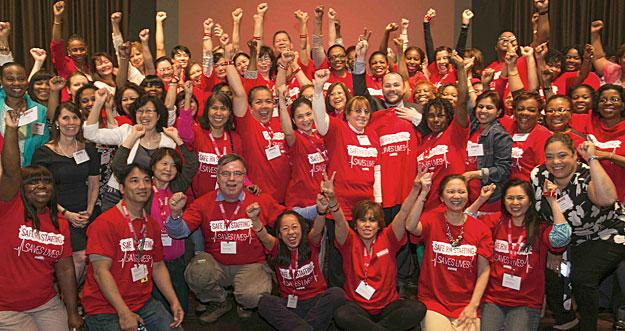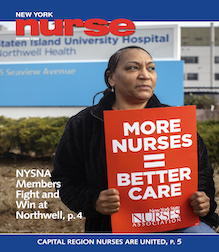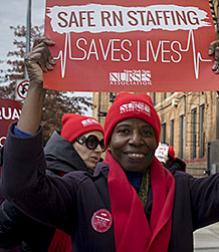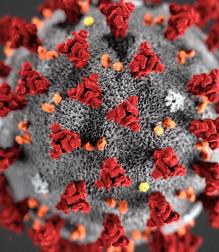
Hundreds of nurses from all parts of the state gathered in New York City on May 29 for NYSNA’s public sector conference. It was the second such meeting and the enthusiasm was palpable — as the spirit, commitment and camaraderie that is the public sector was abundant. Like many others in attendance, Andrew Palm, RN, who works for Cortland County’s Health Department, made the trip “to get together with a huge group of other nurses, share ideas, and learn from one another.”
Strengths and victories
There was much to celebrate on this second occasion of public sector nurses and supporters. One year ago, HHC nurses ratified in overwhelming numbers an outstanding contract with wage hikes, retroactive pay, benefits — adding new funds for education, child and elder care, and more. Last September, members at Erie County Medical Center, likewise, settled a deal covering seven years.
Our public system also stood out last fall in the extraordinary work carried out in the face of Ebola.
Just this May, an important win in dialysis care was scored, as HHC cancelled its contract with a for-profit company, Big Apple Dialysis Management, taking off track efforts to outsource patient services. This win entailed efforts by NYSNA and patients, as well as by doctors, public health experts, other labor unions and community supporters. Developing an evidence-based campaign, part of the nurse DNA, NYSNA presented data to the New York State Department of Health that showed higher death rates for patients in the for-profit system. Chronic dialysis patients at four HHC facilities — Metropolitan, Lincoln, Harlem and Kings County hospital — will now remain under the care of NYSNA nurses in units proven to provide excellent care and outcomes. Patients over profits.
City Council Member Corey Johnson, chair of the Council’s Health Committee, took time to attend the conference and congratulated NYSNA for our defense of dialysis patients in the public system, saluting our commitment to the public’s health and to turning back privatization. Johnson’s support throughout the 18-month campaign to stop Big Apple Dialysis attempted takeover was strong and consistent, as were spirited efforts by Public Advocate Letitia James, who joined our nurses on two occasions to testify before state authorities on the matter.
New York City Comptroller Scott Stringer spoke to us during a lunchtime presentation, thanking nurses for our work and dedication.
Unity among NYSNA public sector is strong and endures, but one message at this year’s conference was clear: We can and must defend unions in New York and help to win back union rights where they have been denied elsewhere in the nation.
Nurses, teachers, firefighters, corrections officers, sanitation workers, and other public sector workers have been the focus of a stepped up, multi-pronged attack in recent years. Their bargaining rights, pensions, wages — their very jobs — are threatened in historically-strong union states of the Midwest and Mid-Atlantic. NYSNA’s public sector nurses have a critical role to play in extending our winning strategies and messages to other states and locales.
Voting matters
One lesson nurses heard: elections have consequences. Franchelle Hart, executive director of Open Buffalo, a coalition of community organizations, reminded nurses that “the 1% can out-spend us, but they can’t compete with our numbers. Everything we do today means nothing if we don’t vote.” Janet Malveda, RN, Bellevue Hospital, urged RNs at her table to “engage the young nurses in your departments and get them politically mobilized — and registered to vote.”
Westchester County Medical Center RN James Galvin said that he and 15 co-workers came to the conference “because we’ve heard that there will be a Constitutional Convention in 2017 that will impact public pensions and the Taylor Law.” New York’s Taylor Law prohibits strikes by public employees. Participants shared ideas and strategies on tactics such as using informational picketing, speaking up at public forums of regulatory bodies, and engaging elected officials to get results.
Katrina Reynolds, an RN at Erie County Medical Center, spoke about the impact of funding cuts on her hospital: “Short staffing is pervasive throughout the whole system. Funding cuts lead to short staffing, which leads to increased readmissions. It creates a vicious cycle. We want to break the cycle.” Areesa Ali, RN, Metropolitan Hospital, concurred, adding, “Less money in the system leads to less care and poor outcomes.”
A range of support and ideas at workshops
Nurses welcomed Dr. Frank Proscia, president, Doctors Council/SEIU, with open arms. Doctors Council nephrologists in the HHC system had stood up in support of dialysis nurses and patients earlier this year, putting out a letter to the public against for-profit Big Apple Dialysis. The solidarity displayed by Dr. Proscia and his colleagues was outstanding, helping to underscore the values of quality, patient care for all that define the public system.
At the podium, Dr. Proscia, was a presenter at a workshop entitled, “Tales from the Front Lines: Dismantling of Public Nurses’ Rights Negatively Affects Patient Care in the Public Sector,” during an afternoon session. Fresh from a contract win at Elmhurst Hospital, Eric Scherzer, executive director, Committee of Interns & Residents/SEIU, was also there. Other panelists were Judith Arroyo, RN, president, Local 436, DC 37; Anne Twomey, RN, president, HPAE, AFT; Winslow Luna, vice president, 1199SEIU; and Sean Petty, RN, and NYSNA board member, acted as workshop facilitator.
Among the research presented were studies that have confirmed that patient outcomes improve in healthcare settings staffed by union caregivers.
“The War on Public Sector Pensions and its Influence on Access to Healthcare in Retirement,” was the workshop title of a presentation given by Diane Oakley, executive director, National Institute for Retirement Security, above. How are trends that undercut pensions affecting nurses in both the public and private sector? Ms. Oakley’s comments helped nurses understand these trends and furthered their knowledge of Medicare and Social Security.
Other workshops examined the public sector dialysis campaign, DSRIP — the Delivery System Reform Incentive Program, and evidence-based models in public health-nurse family-partnerships.
At the conference conclusion, three members — Jalisa Saud, RN, Elmhurst Hospital, Jane Barrett, RN, Westchester Medical Center, and Teresa Edgerton, RN, Erie County Department of Health, gave concluding remarks, facilitated by Verginia Stewart, RN, Metropolitan Hospital and director at large, NYSNA’s board. “Being a nurse leader,” said Ms. Barrett, “is about supporting nurses and advocating for patient care, two things that can be more challenging to do when you’re working in the public sector. Not only do we have the sickest patients, but many have no insurance and are low-income. We always give the best care we can give, regardless.”




